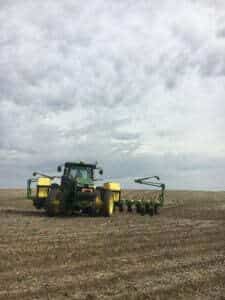
Corn planting season has begun in Nebraska, and farmers are expected to invest nearly $2.7 billion into this year’s crop.
Nebraska corn farmers will plant 10.5 million acres of corn in 2020 according to the latest Prospective Plantings report released by the U.S. Department of Agriculture (USDA). This is nearly a 4% increase from last year’s total planted corn acres. If these planting estimates hold up, Nebraska corn farmers will invest nearly $2.7 billion dollars into the state’s economy over a two-month period. This amount is a result of inputs, such as seed, fuel and fertilizer, but does not include land costs, labor or equipment. Despite the seemingly high investments now, the full economic impact will be realized over time.
“The total investment Nebraska corn farmers make during the planting season is substantial,” said Kelly Brunkhorst, executive director of the Nebraska Corn Board. “This investment really sets the stage for the entire growing season. However, farmers are concerned this year. They’re experiencing difficult financial times, which is leading to much uncertainty. We’re hopeful the current economic conditions improve and the full economic impact of this year’s planted corn crop is realized.”
Farmers in Nebraska historically begin to plant their corn in mid-April and try to finish by mid-May. However, weather often dictates when farmers can plant. The latest Crop Progress report issued by the USDA (released April 20, 2020), showed Nebraska farmers are 2% completed with corn planting, which is ahead of this time last year (1%), but behind of the five-year average (5%).
Even though the corn industry is an economic booster for Nebraska, farmers face challenges in the months ahead. The National Corn Growers Association (NCGA) recently released a report highlighting revenue declines for corn farmers due to COVID-19. Based on this report and further analysis from the Nebraska Corn Board (NCB), corn prices have declined by 20% in Nebraska as a result of the COVID-19 pandemic. Projections show an average loss of $52 per acre in Nebraska, or nearly $512 million.
“Farming is an unpredictable business, and there’s a lot of risk involved,” said David Bruntz, chairman of NCB and farmer from Friend. “It’s necessary to invest a great deal to produce high-quality, high-yielding crops. However, there are so many unknowns, from weather fluctuations, input prices and global pandemics. Thankfully, farmers are resilient and we keep going no matter what.”
Nationally, farmers are estimated to plant nearly 97 million acres of corn in 2020, which is up 8% from last year. For more crop progress information throughout the year, follow the Nebraska Corn Board on Facebook, Twitter and Instagram.
Related Articles
Nebraska Corn Board Event Management Internship Opportunity in Washington, D.C.
The Nebraska Corn Board (NCB) is seeking applicants to participate in an event management internship hosted in Washington, D.C., in conjunction with the U.S. Grains Council. The internship is designed to provide students with [...]
Nebraska Corn Board and Nebraska Soybean Board to Sponsor Grain Bin Rescue Equipment and Training
The Nebraska Corn Board (NCB) and Nebraska Soybean Board (NSB) are partnering to improve grain bin safety by donating two grain rescue tubes and two training sessions to fire and rescue departments in Nebraska. [...]

